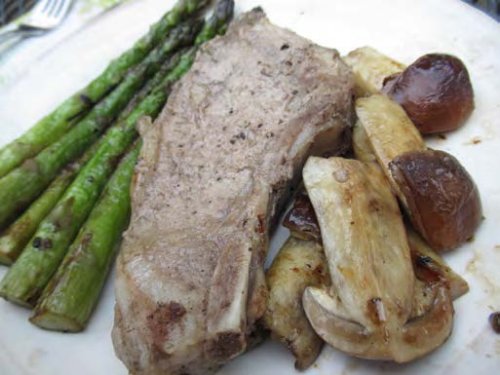AgEBB-MU CAFNR Extension
Green Horizons
Volume 23, Number 2
Spring 2019
Agroforestry
Cultivation and Cuisine: Getting Started with Wine Cap Mushrooms
By Hannah Hemmelgarn | University of Missouri Center for Agroforestry
Mushroom cultivation is a rapidly growing enterprise; The American Mushroom Institute reports that sales increased nearly 10% between 2017 and 2018. Consumers are realizing the tremendous health benefits of edible and medicinal mushrooms, and growers are realizing the ease with which fungi can be integrated in farm and home-scale systems. Bed-grown mushrooms, including oysters (Pleurotus ostreatus) wine caps (Stropharia rugosoannulata), blewits (Clitocybe nuda), and almond agaricus (Agaricus subrufescens), can be cultivated outdoors in a growing medium other than logs; these mushrooms grow well in straw mulch, woodchips, or compost. If you're new to working with fungi, there are some key factors to consider before "planting" mycelium.
 |
Freshly harvested wine cap mushrooms grow well in straw and woodchip mulch beds. Their "stem butts" can be transplanted to other parts of your farm or garden. |
While there are around 145,000 known species of fungi on planet earth (and an estimated 5 million more that have yet to be identified), relatively few are cultivated.
Saprotrophic fungi obtain their energy from non-living organic matter; these are the most commonly cultivated fungi. Whether or not you like to eat them, we can all be grateful for saprotrophic fungi; they work day in and day out to build soil by breaking down fibrous materials.
Most bed-grown mushroom species are saprotrophs; as such, they will "consume" the straw or woodchip mulch you provide them and must be "fed" more in order to continue to thrive.
Wine cap mushrooms are abundant producers that will begin to fruit after just six months from inoculation time. Even the stems of this mushroom are delicious, and they can easily be propagated from mycelium masses into other parts of your garden.
How to Grow Stropharia rugosoannulata (wine cap) Mushrooms
Before you get started, assess your mushroom cultivation objectives by asking yourself the following questions: Am I going to grow mushrooms for personal consumption or for sale?
If I'm growing them to sell, what is the market for this variety of mushrooms in my area? Are there people already selling mushrooms at my local farmers market, grocery stores, or to restaurants?
Who will buy my product, and how much can I expect to grow given the space I have dedicated to this purpose? How much can I sell them for? Will this price account for my upfront and ongoing costs, including labor?
Obtain about 1 cubic yard of slightly aged hardwood tree woodchips (these can be easily acquired from tree pruning companies or city utility workers) and/or a couple bales of straw. Submerge straw bales and/or chips in a stock tank or large tub of water for 1-3 days.
Winecap mushrooms need soil contact, so clear your growing site before spreading a few inches of woodchips. Sprinkle sawdust spawn over the area generously and cover with an additional 2 inches of chips or straw. Sprinkle another layer of spawn over the growing medium and continue to layer with soaked straw and chips until you have exhausted your soaked growing medium supply.
 |
To cook wine cap mushrooms, slice each one from top to bottom, in half or quarters, and sautee for ~20 minutes with any cooking oil or other fat, in an open pan to allow moisture in the mushrooms to evaporate. Add salt and pepper to taste. A little tamari or soy sauce enhances their meaty flavor. Enjoy your wine cap mushrooms paired with asparagus and rice, piled on a hamburger, or in combination with other spring vegetables. |
Cover the bed with a thick layer of dry straw or a tarp to prevent it from drying out. One 5.5 lb bag of spawn will cover a 30-50 square foot area 4-6 inches deep. After a couple months, remove the tarp and peek into the bed to check for mycelium colonization.
Allow spring rain to keep the bed moist and watch for small humps in the mulch where mushrooms may be emerging. Harvest wine caps just before the caps break free from the "annulata" or ring around the stem.
